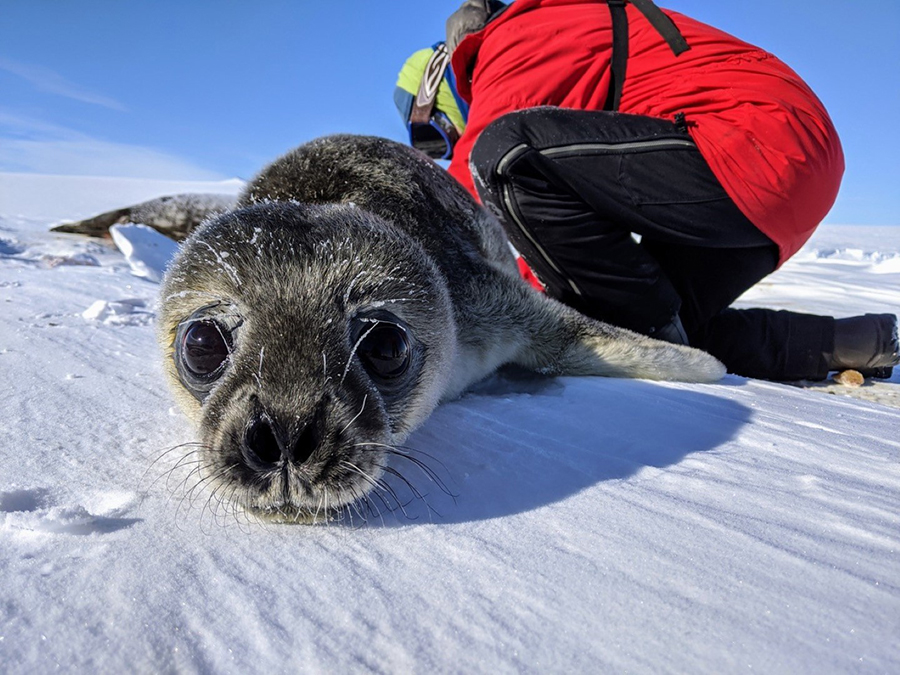Counting on SealsDespite COVID, scientists keep a half-century-long dataset goingPosted February 1, 2021
Seal science in Antarctica continues, even as the COVID-19 pandemic spread across the world. 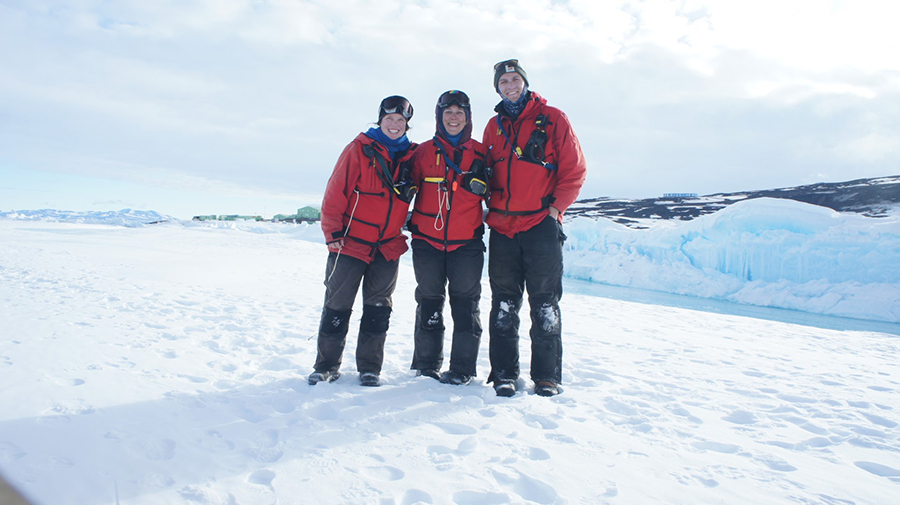
Photo Credit: Kaitlin Macdonald
The 2020 seal team field crew. From left to right, Kaitlin Macdonald, Parker Levinson and Will McDonald.
Fewer researchers and support staff traveled to Antarctica in 2020 to reduce the risk of introducing the virus to the continent. One of the few science teams that did go is working on the long-term study of Weddell seals in McMurdo Sound. "We're trying to understand how things mothers do for their offspring might help those pups do better or do worse later in life," said Jay Rotella, an ecologist at Montana State University and principal investigator on the project. It's a project that's been going on for more than half a century and offers critical insights into the health of the Antarctic ecosystem in the face of climate change. Numerous research groups rely on the team's work, and even a single year's disruption would be irreparably detrimental to their data. After reducing their numbers to the bare minimum and forgoing their usual field camp, they worked out of McMurdo Station to minimize their need for staff support. Their research is supported by the National Science Foundation, which manages the U.S. Antarctic Program. Data-Driven Seal StudyLearning how seal mothers raise their pups is a major hands-on effort. Every year, researchers travel around and log every animal in the region. "We count the seals," Rotella said. "We spend a lot of time walking around seal colonies, tagging pups and recording which animals are still alive and which ones have given birth." In many ways, Weddell seals of McMurdo Sound are the ideal animal to study. The docile creatures are easy for the researchers to work with and they return to accessible pupping colonies year after year. Their proximity to McMurdo Station makes logistics simpler, and easy to correlate additional environmental and other datasets collected nearby. Getting a complete picture of the seals in the region gives the team a detailed look at what influences their population. 
Photo Credit: Will McDonald
A baby seal reclines on the sea ice next to its mother. Weddell seals will spend the first seven or so weeks of their lives learning how to swim and hunt from their mothers.
"We tag every single pup that's born in the study area and that's pretty much the most important thing we do," Kaitlin Macdonald, a graduate student at Montana State University and the leader of the field team. "That allows us to know how many pups were born and it allows us to associate mothers with pups so we know what seals had a pup in a given year, and what females didn't. That allows us to estimate reproduction rates and it also allows us to have known ages of individuals when those pups come back as adults… We also look at things such as when do females first reproduce and when do they have a higher reproduction versus a lower reproduction rate and does that change throughout their lives." Seal pups stick close to their mothers until they wean, which is how the researchers identify family lines. Each year the team attaches a small colored tag to the flipper of every newborn seal pup to record where they were born and to whom. Later in life, female seals tend to return to the area where they were born to give birth so the research team uses their tags to track which seals return to the area to help determine their survival rates. Maintaining an unbroken family lineage dataset is the key to understanding what traits and behaviors contribute to raising a successful seal pup, and what influence the environment has as well. "By keeping the data intact, we're doing two things. Every year we know how that population is doing and how it's responding to whatever the sea ice conditions were each year, and what was going on with fishing and other activities," Rotella said. "We're also putting lifetime reproductive histories together for all the females that were born in the study area." Had the team been unable to travel to Antarctica, it likely would have caused an irreparable disruption to their dataset. It's impossible to tell how old a seal is just by looking at them, and the ages that females start to reproduce and at what ages that reproduction is most or least successful are central to the team's research. "If we didn't go, we wouldn't know who was still alive and we wouldn't know who had a baby," Rotella said. "It would also mean that the five or six hundred babies that were born this year would go untagged and therefore we would never be able to know their ages." Iterations of this project have been maintaining this data for more than fifty years. Such a long and meticulous dataset is immensely valuable to researchers asking a wide range of questions about the Antarctic ecosystem. "This project has been collecting data this way since the 1960s and it's one of the longest-running projects on a long-lived mammal in the world," Rotella said. "[They're] a sentinel of the Southern Ocean, a bell weather for how the ecosystem is doing." 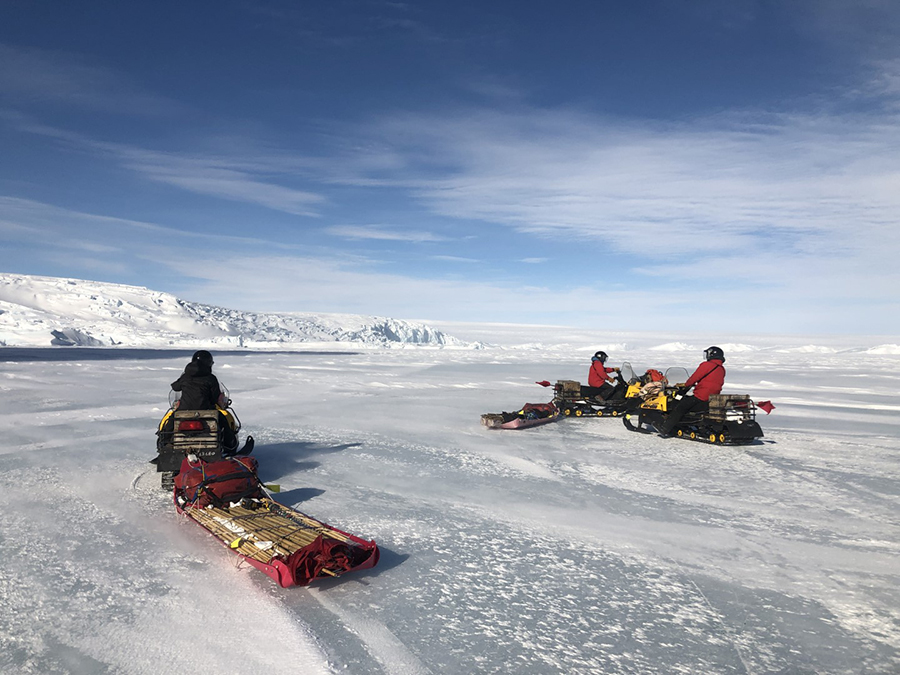
Photo Credit: Parker Levinson
To reach the seal colonies they would normally be camped near, the team drove snowmobiles over miles of frozen sea ice from McMurdo Station every morning.
Understanding how seals respond to environmental changes and what that indicates about the health of their surrounding ecosystem has taken on an extra impetus as the broad changes associated with climate change are beginning to manifest itself throughout the icy continent. In addition, a range of other researchers that are either studying seals in the area, or other aspects of the region's ecosystem rely on the data collected by Rotella's team. "A lot of projects will use our data in some capacity," Macdonald said. "Getting the data this year not only helps our project but helps future projects." Science During a PandemicThough never routine, traveling to Antarctica during a global pandemic was especially challenging to make sure no one inadvertently brought the COVID-19 virus with them. The team left their homes on September 11 and traveled to San Francisco international airport. Upon arriving, the team and about 200 other scientists and support staff traveling to McMurdo Station, quarantined in the airport hotel until their entire cohort tested negative for COVID-19. After five days in isolation and a negative COVID test, the cohort boarded a specially chartered plane for Christchurch, New Zealand. Once there, they isolated in a Christchurch hotel under a government-mandated two-week quarantine. After two more rounds of negative tests, they boarded their flight heading south early morning on October 6, and touched down at McMurdo Station five hours later. After arriving on station, they found seals reclining on top of the sea ice, much as the team had left them the previous year. "It's interesting to see the colonies just kind of keep going on. They don't know a pandemic is happening," Macdonald said. Though the virus has not reached any U.S. Antarctic Program research stations, the extra safety measures put in place have impacted life in Antarctica. "There were a lot of big differences this year," Macdonald said. "This was my sixth season so I kind of have a routine and I am kind of used to us doing certain things and getting to them at certain times. It just became pretty apparent that we weren't going to be able to achieve all the things we're normally able to do… We're going to get the really important baseline data that we need to have, and if we do extra things beyond that, other side projects we've been working on, that's awesome, and if not, that's ok." To reduce the risk of Coronavirus reaching anyone in Antarctica, staffing at McMurdo Station was reduced, and the number of science projects and scientists was significantly scaled back. "Our team is only three people this year instead of the normal six to seven, so the workload is a little heavier on those who are there," said Rotella, who didn't travel to the continent as he would in a typical year. "We had to pull back a little bit because of the reduced team, but we're getting the core work done, which is awesome, and we feel very fortunate to be there and glad we can keep the data string intact." In addition, the limited workforce at the station meant that the team's usual field camp couldn't be set up. 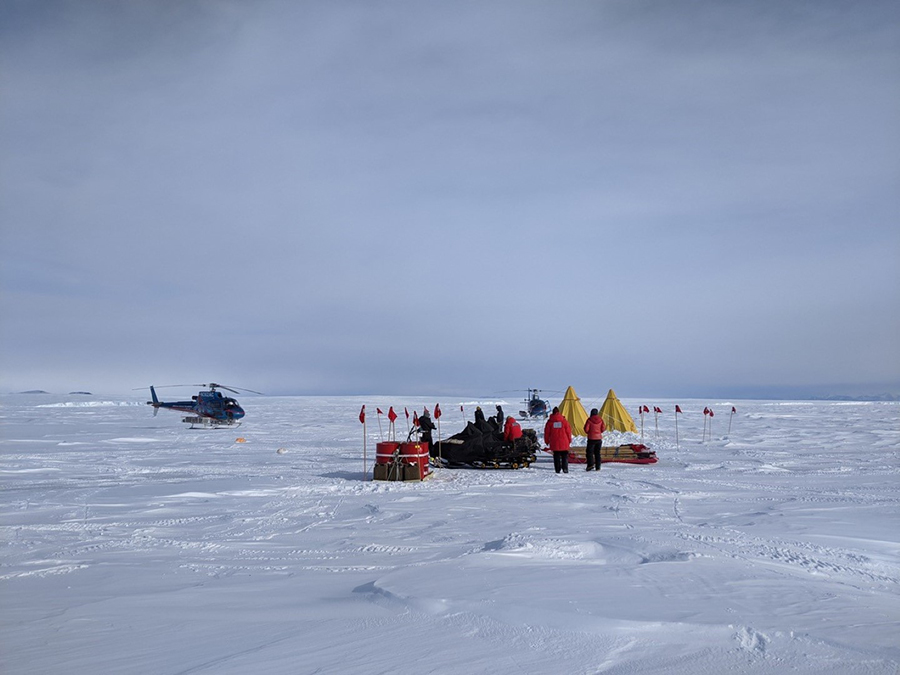
Photo Credit: Parker Levinson
Because of the difficult ice conditions this year, some of the nearby colonies could only be reached by helicopter. For these sites, the team set up a small emergency cache of supplies and shelter in case bad weather prevented the helicopters from picking them up.
"In a typical year our team of six to seven people have four little huts, kind of look like storage containers that are on skis… out onto the sea ice about 12 miles away from McMurdo," Rotella said. "We have a little kitchen and office hut, a little storage hut for work benches where we can hang dirty gear and clean gear and let things dry out, and then we have two bunk huts, so we live in close quarters with six or seven people. Instead of operating out of a camp adjacent to the seal colony Big Razorback Island, the science team stayed at McMurdo Station and traveled to the colonies on snowmobiles. "Every day was a lot longer and I think it just took a while to get used to that reality," Macdonald said. "I think our commutes were an hour and a half longer than they normally would be just from working from McMurdo." They slept in the dorms on station, used the Albert P. Crary Science and Engineering Research Center as their base of operations and kept their field supplies stored next to their parked snowmobiles for easy access. Though faced with a lot of obstacles, they were able to continue their research. "By being in the field this season, we are able to continue to do the follow-up work on how those individual pups are faring and to learn if features of those pups, their mothers, and the environmental conditions they have faced over the years matter to their survival and reproduction," Rotella said. Overcoming ChallengesIndependent of the effects of the pandemic, the team was also challenged by the sea ice conditions near the station. During a typical Antarctic winter, the top few feet of ocean water in McMurdo Sound freezes thick enough to safely set up a camp on top of. However, this time around the ice didn't set in as much as it typically does, leaving vast stretches of the region inaccessible, including where the team normally sets up camp. 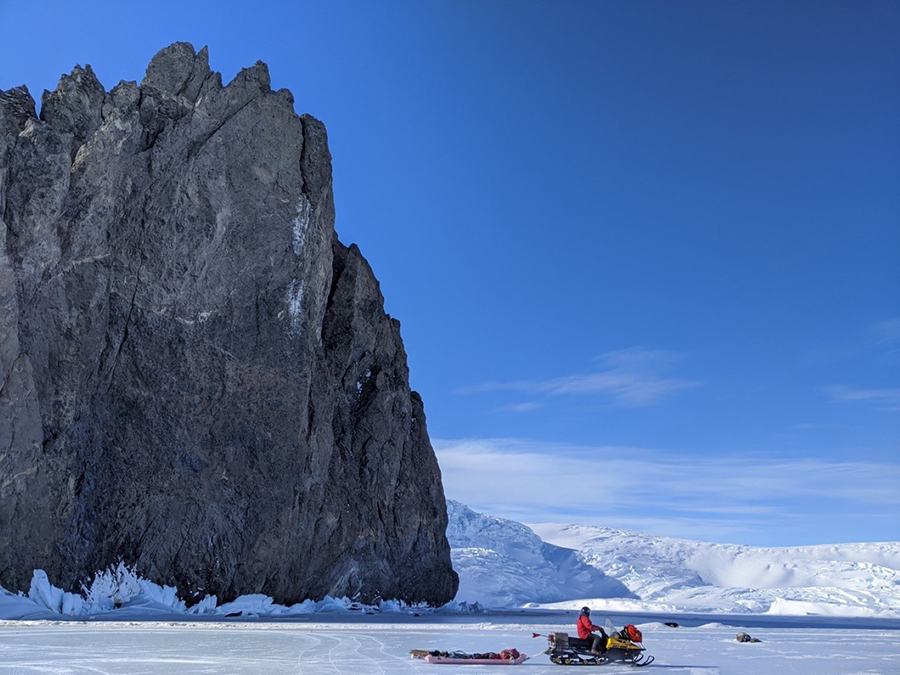
Photo Credit: Parker Levinson
One of the team members drives by Big Razorback, the island that the team would camp next to in a typical year.
"The sea ice edge was much closer than we've recorded in recent years, so a portion of our study area was actually open water," Macdonald said. "There was no way to snowmobile to the Northside of our study area, so it was kind of cut off. What that meant is that we took helicopters over to the north side of our study area. So our time on the north side was a lot more limited than it would be in a normal year." Though the lack of sea ice made for challenging working conditions, the team was glad to be able to record its effects on the region's seal population. "This year is a fantastic year to be there from a science perspective, because we have the least ice we've had in the time we've been on the project, and one of the lowest ice years ever since the late 1970s," Rotella said. "Getting data for how the population responds in a year like this is really excellent for adding to our ability to see how seals respond to changes in the environment and so we're really fortunate to be able to be there in a year like this." Ultimately, fielding a leaner team meant there were some tradeoffs in the amount of data they could collect. "We weren't able to get all the population surveys done that we normally do, so we weren't able to get the minimum number we like to do. We were able to get a few in and I think we'll be able to use that data - we'll just have a little asterisk next to it," Macdonald said. "What it will mean for us this year is that the estimate will have a slightly larger error bar next to it and it will just be a bigger range that estimate could fall in." For the population survey, the team visits each colony to count and record the tag numbers of each seal. They try to visit each colony about six times so as not to miss any that might be diving under the ice when they stop by. Because of this year's various limitations, the team wasn't able to visit the various colonies as often as they would like, but think they were able to collect enough data to be useful. "We'll have to do a little more computer modeling and statistical work to estimate the total population size," Rotella said. "We can do that, it's a little more work back at the university labs, doing the analysis, it will be a little more complicated, but we know how to do it." Also, in a typical year the team would weigh a number of the baby seals and estimate the body mass of their mothers, but they had to suspend that as well. "It's amazing how much support we got from folks in McMurdo. It's been a challenging year for everyone in some capacity," Macdonald said. "It was really great to have the help from all those folks… we really felt just so supported by all the work centers. We really appreciate all their work." NSF-funded research in this story: Jay Rotella, Montana State University, Award No. 1640481. NMFS Permit 21158. |



For USAP Participants |
For The Public |
For Researchers and EducatorsContact UsNational Science FoundationOffice of Polar Programs Geosciences Directorate 2415 Eisenhower Avenue, Suite W7100 Alexandria, VA 22314 Sign up for the NSF Office of Polar Programs newsletter and events. Feedback Form |

